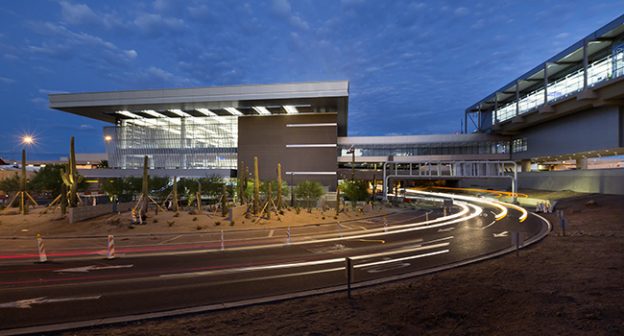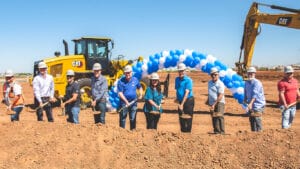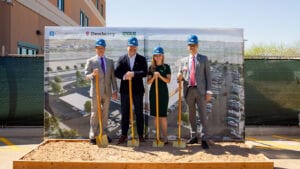You can’t get going without something to guide you forward, and as the Valley moves forward into its next economic chapter, vital pieces of infrastructure are needed to help grease the wheels of economic development.
Funding is still an issue, but there are many funded projects already under construction focused on Metro Phoenix’s infrastructure for its planes, trains and automobiles.
Phoenix Sky Harbor International Airport is in the process of spending $2 billion on upgrades. Phoenix’s 2015 passage of the transit tax from Prop. 104 is making way for decades’ worth of light rail and bus expansions, which will reach parts of the Valley that will even surprise the most optimistic transit lover. And the freeways? The Loop 202 expansion could be a game changer for the Valley.
Here’s a breakdown of some vital infrastructure projects happening right now:
Planes
The second of three phases for Sky Harbor’s Terminal 3 Modernization project is currently underway after it re-opened to the public in December. The modernization will replace all of Terminal 2’s gates, eventually paving the way for its razing.
 Terminal 3’s gates will become more efficient as airlines will share underutilized gates, says Art Fairbanks, special projects administrator for the Terminal 3 Modernization project.
Terminal 3’s gates will become more efficient as airlines will share underutilized gates, says Art Fairbanks, special projects administrator for the Terminal 3 Modernization project.
“This economic engine that feeds all of our tourism and business community here in town can benefit from more traffic, because with the same number of gates we can get greater utilization,” he explains.
The modernization is slated for completion in 2020, and when everything is complete the terminal’s capacity space will increase to 25 gates.
Also at Sky Harbor, the second phase of the SkyTrain is underway. Once complete, the SkyTrain will connect the remaining Sky Harbor facilities together while also creating smoother transitions for travelers from the plane to their rental car or vice versa, says Kyle Kotchou, aviation director for design and construction services at Sky Harbor.
The SkyTrain will reach a new west economy lot and the rental car facility once the SkyTrain additions are finished in late 2021 or early 2022.
Trains
Train may be in the SkyTrain’s name, but there are other train, or rail, related infrastructure additions moving forward in the Valley.
Currently under construction, the 1.9-mile light rail extension on Main Street from Mesa Drive to Gilbert Road is a “big deal,” says Eric Anderson, transportation director at the Maricopa Association of Governments.

Since the start of service in 2008, the 26-mile Valley Metro Rail line has generated nearly $9 billion in economic investment including residential and commercial developments.
Anderson thinks the extension will dramatically increase ridership and the redevelopment potential along the extension is high, Anderson says, as there are many abandoned retail assets along the line.
The Phoenix Transportation 2050 Plan, made possible by Prop. 104, will add 42 miles of light rail across the city, including the South Central light rail extension, which will extend to Baseline Road by way of Central Avenue by 2023.
In Tempe, construction started on June 1 for its local Street Car, which will wrap around ASU’s campus and reach Hayden Ferry Lakeside and Marina Heights.
Automobiles
The Loop 202 extension, which will “complete the loop,” adds 22-miles of freeway to the existing transportation system.
Anderson says this connection will ease the access between the Southeast and Southwest parts of the Valley, connecting many folks to the high-tech jobs in the Southeast.

During Phoenix Mayor Greg Stanton’s State of the City Address, he mentioned the creation of a South Mountain Technology Corridor, which will try to convince advanced manufacturing and emerging industries to locate along the expansion once it’s finished by late 2019.
The creation of these high tech jobs in the Southwest part of the Valley, in places like Laveen, will be able to draw from the talented workforce pool in the Southeast Valley, Anderson says.
“I think [the high tech corridor] is going to change some of the dynamics in the Valley,” Anderson explains. “Hopefully it will lead the creation of better jobs in the west side of the Valley.”





